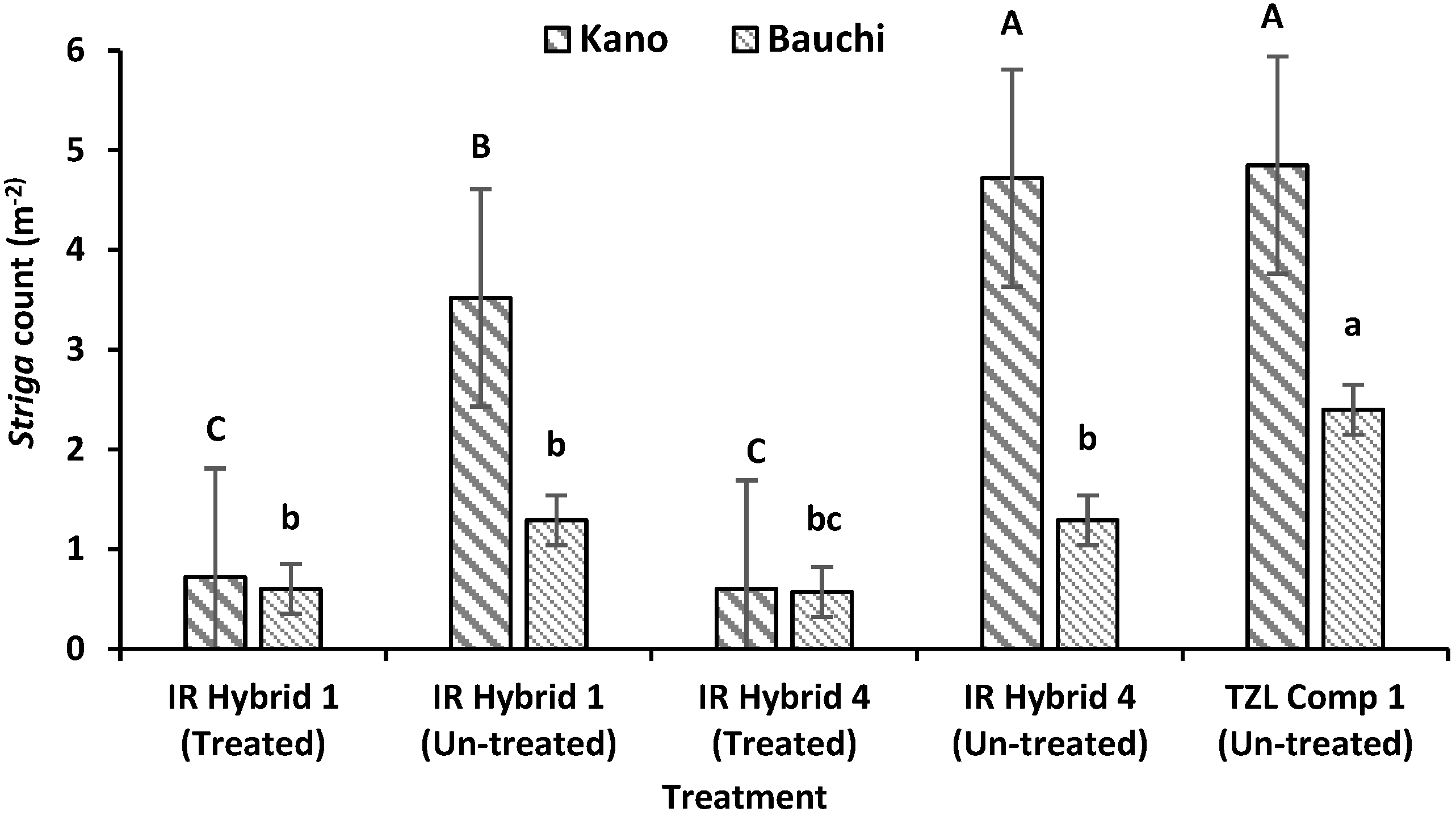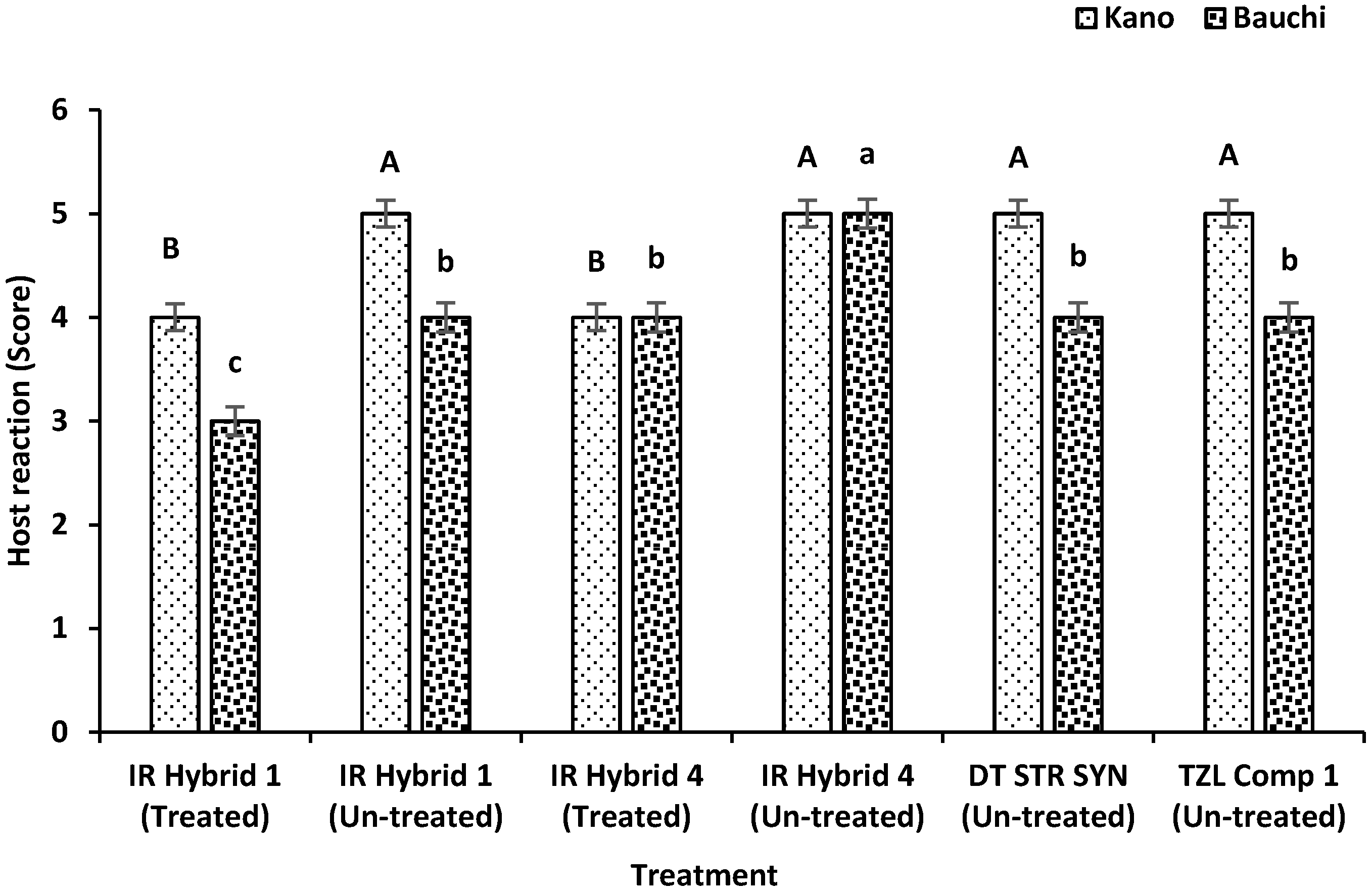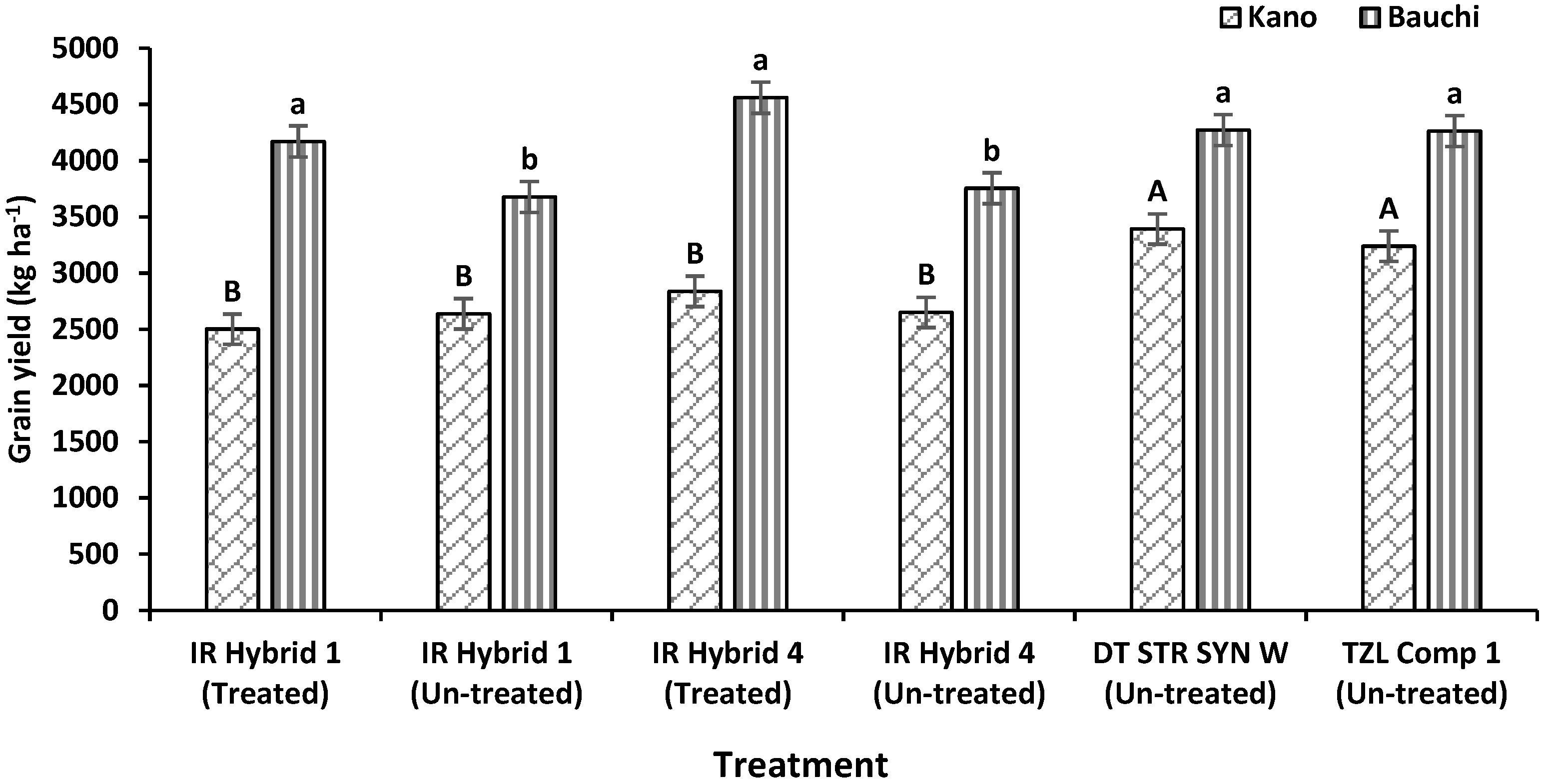Seed Dressing Maize with Imazapyr to Control Striga hermonthica in Farmers’ Fields in the Savannas of Nigeria
Abstract
1. Introduction
2. Materials and Methods
2.1. Study Area
2.2. Planting Materials and Coating
2.3. Cultural Practices, Measurements and Statistical Analysis
3. Results
4. Discussions
5. Conclusions
Author Contributions
Funding
Conflicts of Interest
References
- Oswald, A.; Ransom, J.K. Response of maize varieties to Striga infestation. Crop Prot. 2004, 23, 89–94. [Google Scholar] [CrossRef]
- Sauerborn, J. The Economic Importance of the Phytoparasites Orobanche and Striga. In Proceedings of the 5th International Symposium of Parasitic Weeds, CIMMYT, Nairobi, Kenya, 24–30 June 1991; Ransom, J.K., Musselman, L.J., Worsham, A.D., Parker, C., Eds.; pp. 137–143. [Google Scholar]
- Lagoke, S.T.O.; Parkinson, V.; Agunbiade, R.M. Parasitic weeds and control methods in Africa. In Combating Striga in Africa, Proceedings of the International Workshop Organized by IITA, ICRISAT, and IDRC, Ibadan, Nigeria, 22–24 August 1988; Kim, S.K., Ed.; IITA: Ibadan, Nigeria, 1991; pp. 3–14. [Google Scholar]
- Weber, G.; Elemo, K.; Lagoke, S.T.O.; Award, A.; Oikeh, S. Population dynamics and determinants of Striga hermonthica on maize and sorghum in savanna farming systems. Crop Prot. 1995, 14, 283–290. [Google Scholar] [CrossRef]
- Kim, S.K.; Adetimirin, O. Response of tolerant and susceptible maize varieties to timing and rate of nitrogen under Striga hermonthica infestation. Agron. J. 1997, 89, 38–44. [Google Scholar] [CrossRef]
- Showemimo, F.A.; Kimbeng, C.A.; Alabi, S.O. Genotype response of sorghum cultivars to nitrogen fertilization in the control of Striga hermonthica. Crop Prot. 2002, 21, 867–870. [Google Scholar] [CrossRef]
- Dugje, I.Y.; Kamara, A.Y.; Omoigui, L.O. Infestation of crop fields by Striga species in the savanna zones of northeast Nigeria. Afr. Agric. Ecosyst. Environ. 2006, 116, 251–254. [Google Scholar] [CrossRef]
- Ekeleme, F.; Jibrin, J.M.; Kamara, A.Y.; Oluoch, M.; Samndi, A.M.; Fagge, A.A. Assessment of the relationship between soil properties, Striga hermonthica infestation and the on-farm yields of maize in the dry Savannas of Nigeria. Crop Prot. 2014, 66, 90–97. [Google Scholar] [CrossRef]
- Rodenburg, J.; Bastiaans, L.; Weltzien, E.; Hess, D.E. How can selection for Striga resistance and tolerance in sorghum be improved? Field Crops Res. 2005, 93, 34–50. [Google Scholar] [CrossRef]
- Van Ast, A.; Bastiaans, L.; Katile, S. Cultural control measures to diminish sorghum yield loss and parasite success under Striga hermonthica infestation. Crop Prot. 2005, 24, 1023–1034. [Google Scholar] [CrossRef]
- Oikeh, S.; Weber, G.K.; Lagoke, S.T.O.; Award, A. Estimation of yield losses from Striga hermonthica in farmers’ fields in the northern Guinea savanna of Nigeria. Nigeria J. Weed Sci. 1996, 9, 1–6. [Google Scholar]
- Berner, D.K.; Kling, J.G.; Singh, B.B. Striga research and control: A perspective from Africa. Plant Dis. 1995, 79, 652–670. [Google Scholar] [CrossRef]
- Oswald, A.; Ransom, J.K. Striga control and improved farm productivity using crop rotation. Crop Prot. 2001, 20, 113–120. [Google Scholar] [CrossRef]
- Oswald, A.; Ransom, J.K.; Kroschel, J.; Sauerbom, J. Intercropping controls Striga in maize based farming systems. Crop Prot. 2002, 21, 367–374. [Google Scholar] [CrossRef]
- Combari, A.; Pineau, R.; Schiavon, M. Influence du degree de decomposition de produits organic sur 101 germination de graines de Slriga hermonlhica (Od.) Benth. Weed Res. 1990, 30, 29–34. [Google Scholar] [CrossRef]
- Mumera, L.M.; Below, F.E. Role of nitrogen in resistance to Striga parasitism in maize. Crop Sci. 1993, 33, 158–763. [Google Scholar] [CrossRef]
- Ransom, J.K. Long term approaches for the control of Striga in cereals: Field management. Crop Prot. 2000, 19, 759–763. [Google Scholar] [CrossRef]
- Kanampiu, F.K.; Ransom, J.K.; Gressel, J. Imazapyr seed dressings for Striga control on acetolactate synthase target-site resistant maize. Crop Prot. 2001, 20, 885–895. [Google Scholar] [CrossRef]
- Abayo, G.O.; English, T.; Eplee, R.E.; Kanampiu, F.K.; Ransom, J.K.; Gressel, J. Control of parasitic witchweeds (Striga spp.) on corn (Zea mays) resistant to acetolactate synthase inhibitors. Weed Sci. 1998, 46, 459–466. [Google Scholar] [CrossRef]
- Berner, D.K.; Ikie, F.O.; Green, J.M. ALS-inhibiting herbicide seed treatments control Striga hermonthica in ALS-modified corn (Zea mays). Weed Technol. 1997, 11, 704–707. [Google Scholar] [CrossRef]
- Kanampiu, F.K.; Karaya, H.; Burnet, M.; Gressel, J. Needs for and effectiveness of slow release herbicide seed treatment Striga control formulations for protection against early season crop phytotoxicity. Crop Prot. 2009, 28, 845–853. [Google Scholar] [CrossRef]
- Chikoye, D.; Lum, A.F.; Menkir, A. Seed coating herbicide tolerant maize hybrids with imazapyr for Striga hermonthica (Del.) Benth control in the West African savanna. J. Food Agric. Environ. 2011, 9, 416–421. [Google Scholar]
- Ransom, J.; Kanampiu, F.; Gressel, J.; De Groote, H.; Burnet, M.; Odhiambo, G. Herbicide Applied to Imidazolinone Resistant-Maize Seed as a Striga Control Option for Small-Scale African Farmers. Weed Sci. 2012, 60, 283–289. [Google Scholar] [CrossRef]
- Abayo, G.O.; Ransom, J.K.; Gressel, J.; Odhiambo, G.D. Striga hermonthica control with acetolactate synthase inhibiting herbicides seed dressed to maize with target site resistance. In Advances in Parasitic Plant Research, Proceedings of the 6th International Symposium on Parasitic Weeds, Cordoba, Spain, 16–18 April 1996; Moreno, M.T., Cubero, J.I., Berner, D., Joel, D., Musselman, L.J., Parker, C., Eds.; Junta de Andalucı’a: Sevilla, Spain, 1996; pp. 616–623. [Google Scholar]
- Menkir, A.; Chikoye, D.; Lum, F. Incorporating an herbicide resistance gene into tropical maize with inherent polygenic resistance to control Striga hermonthica (Del.) Benth. Plant Breed. 2010, 129, 385–392. [Google Scholar]
- Hagmann, J.; Chuma, E.; Murwir, K.; Connolly, M. Putting process into practice: Operationalising participatory extension. Netw.-Pap.-Agric.-Res.-Ext.-Netw.-ODI (UK) 1999, 94, 23. [Google Scholar]
- SAS. SAS/STAT User’s Guide, 5th ed.; Statistical Analysis System Institute Inc.: Cary, NC, USA, 2012; Volume 1. [Google Scholar]
- Carsky, R.J.; Berner, D.K.; Oyewole, B.D.; Dashiell, K.; Schulz, S. Reduction of Striga hermonthica parasitism on maize using soybean rotation. Int. J. Pest Manag. 2000, 46, 115–120. [Google Scholar] [CrossRef]
- Khan, Z.R.; Pickett, J.A.; van den Berg, J.; Wadhams, L.J.; Woodcock, C.M. Exploiting chemical ecology and species diversity: Stem borer and Striga control for maize and sorghum in Africa. Pest Manag. Sci. 2000, 56, 957–962. [Google Scholar] [CrossRef]
- Gacheru, E.; Rao, M.R. Managing Striga infestation on maize using organic and inorganic nutrient sources in western Kenya. Int. J. Pest Manag. 2001, 47, 233–239. [Google Scholar] [CrossRef]
- Badu-Apraku, B.; Oyekunle, M.; Obeng-Antwi, K.; Osuman, A.S.; Ado, S.G.; Coulibaly, N.; Yallou, C.G.; Abdulai, M.; Boakyewaa, G.A.; Didjeira, A. Performance of extra-early maize cultivars based on GGE biplot and AMMI analysis. J. Agric. Sci. Camb. 2012, 150, 473–483. [Google Scholar] [CrossRef]
- Menkir, A.; Makumbi, D.; Franco, J. Assessment of reaction patterns of hybrids to Striga hermonthica (Del.) Benth. Under artificial infestation in Kenya and Nigeria. Crop Sci. 2012, 52, 2528–2537. [Google Scholar] [CrossRef]
- Makumbi, D.; Diallo, A.; Kanampiu, F.; Mugo, S.; Karaya, H. Agronomic Performance and Genotype x Environment Interaction of Herbicide-Resistant Maize Varieties in Eastern Africa. Crop Sci. 2015, 55, 540–555. [Google Scholar] [CrossRef]
- Kanampiu, F.; Diallo, A.; Burnet, M.; Karaya, H.; Gressel, J. Success with the low biotech of seed-coating imidazolinone-resisatnt maize. In Integrating New Technologies for Striga Control: Towards Ending the Witch-Hunt; Ejeta, G., Gressel, J., Eds.; World Scientific: Singapore, 2007; pp. 145–158. [Google Scholar]
- Kabambe, V.H.; Kanampiu, F.; Ngwira, A. Imazapyr (herbicide) seed dressing increases yield, suppresses Striga asiatica and has seed depletion role in maize (Zea mays L.) in Malawi. Afr. J. Biotechnol. 2008, 7, 3293–3298. [Google Scholar]
- Kamara, A.Y.; Ewansiha, S.U.; Menkir, A.; Tofa, A.I. Agronomic response of drought-tolerant and Striga-resistant maize cultivars to nitrogen fertilization in the Nigerian Guinea savannas. Maydica 2012, 57, 114–120. [Google Scholar]
- De Groote, H.; Wangare, L.; Kanampiu, F. Evaluating the use of herbicide-coated imidazolinone-resistant (IR) maize seeds to control Striga in farmers’ fields in Kenya. Crop Prot. 2007, 26, 1496–1506. [Google Scholar] [CrossRef]






| State | Number of Fields | Communities |
|---|---|---|
| Kano | 30 | Jibga, Bebeji, Durmanawa, Kofa, Wak, Cutar biki, Anadariya, Gargai, Gidan wake, Tashar Idi, Gidan Dagazau, Rurum, tadinsha, Gidan Gizo, Yado, Gimbawa, Kyangarang, Tashar Goro, Kuguru, Yaryasa, Sumana. |
| Bauchi | 30 | Lando, Gidan Sarkin yamma, Dorza, Kwaffa, Felufelu, Tukari, Yashi, Garin Galadima, Dass, Zaranda, Burgel, Gital, Banko, Takwashide Kafin madaki, Kwanar Labi, Kafin Liman, Zamo |
© 2020 by the authors. Licensee MDPI, Basel, Switzerland. This article is an open access article distributed under the terms and conditions of the Creative Commons Attribution (CC BY) license (http://creativecommons.org/licenses/by/4.0/).
Share and Cite
Kamara, A.Y.; Menkir, A.; Chikoye, D.; Solomon, R.; Tofa, A.I.; Omoigui, L.O. Seed Dressing Maize with Imazapyr to Control Striga hermonthica in Farmers’ Fields in the Savannas of Nigeria. Agriculture 2020, 10, 83. https://doi.org/10.3390/agriculture10030083
Kamara AY, Menkir A, Chikoye D, Solomon R, Tofa AI, Omoigui LO. Seed Dressing Maize with Imazapyr to Control Striga hermonthica in Farmers’ Fields in the Savannas of Nigeria. Agriculture. 2020; 10(3):83. https://doi.org/10.3390/agriculture10030083
Chicago/Turabian StyleKamara, Alpha Yaya, Abebe Menkir, David Chikoye, Reuben Solomon, Abdullahi Ibrahim Tofa, and Lucky O. Omoigui. 2020. "Seed Dressing Maize with Imazapyr to Control Striga hermonthica in Farmers’ Fields in the Savannas of Nigeria" Agriculture 10, no. 3: 83. https://doi.org/10.3390/agriculture10030083
APA StyleKamara, A. Y., Menkir, A., Chikoye, D., Solomon, R., Tofa, A. I., & Omoigui, L. O. (2020). Seed Dressing Maize with Imazapyr to Control Striga hermonthica in Farmers’ Fields in the Savannas of Nigeria. Agriculture, 10(3), 83. https://doi.org/10.3390/agriculture10030083





